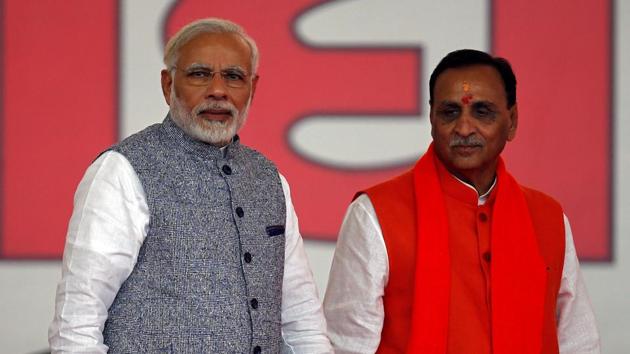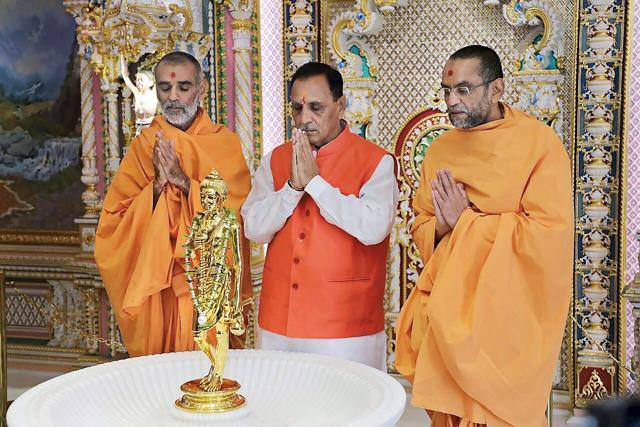Vijay Rupani takes oath as Gujarat CM; Patidars, OBCs get equal representation
Vijay Rupani, who has become the state chief minister for a second time in a row, was sworn-in along with 19 others in the presence of PM Narendra Modi and BJP chief Amit Shah.
Vijay Rupani, a low-profile Rashtriya Swayamsevak Sangh (RSS) man, on Tuesday took oath as the chief minister of Gujarat for the second consecutive term with new faces and the strong presence of Patidar leaders in his ministry.

Rupani, 61, his deputy Nitin Patel and 18 other ministers were administered the oath of office and secrecy by governor OP Kohli at a grand ceremony in Gandhinagar in the presence of Prime Minister Narendra Modi, Bharatiya Janata Party president Amit Shah and chief ministers of the18 BJP-ruled states.
Ally Janata Dal(United)’s Bihar chief minister Nitish Kumar and a host of Union ministers were also present at the function.
“Development will remain the driving force for the BJP government,” said Rupani, who arrived at the venue after offering prayers at Panchdev Mahadev Temple.
Lean cabinet
Rupani will begin his second term with a lean cabinet of 18 ministers besides Patel as the deputy chief minister. As many as eight ministers have been given the cabinet rank while 10 will be ministers of state.
Patel’s continuance as Rupani’s deputy is being read as a signal to the influential Patidars that the community will be well represented in the ministry.
After the election that the BJP won with a simple majority, the caste and regional balance have been maintained with six Patidars, six Other Backward Class, three Scheduled Tribe, one Scheduled Caste, two Kshatriya and two upper caste leaders being inducted in the government.
The BJP retained power in the state for the sixth consecutive term by winning the recently held assembly polls.
The saffron party’s tally in the elections conducted in two phases on December 9 and 14 has remained 99, 16 seats less than it got in the 2012 elections in the 182-member assembly. The Congress, in its best performance since 1990, won 77 seats. The strength of the Congress and its allies in the new House is 80.
From winning 32 of 48 seats in Saurashtra region in 2012, the BJP’s tally slid to 19 in 2017. The Congress, boosted by support from Hardik Patel, convener of Patidar Anamat Andolan Samiti, made inroads into Saurashtra.
The politically influential Patidars, who constitute around 12% of state’s 60 million population, hold sway in nearly 60-odd seats.
| NAME | DESIGNATION |
| Vijay Rupani | Chief Minister |
| Nitinkumar Ratilal Patel | Deputy Chief Minister |
| Bhupendrasinh Manubha Chaudasama | Cabinet Minister |
| Ranchhodbhai Chanabhai Faldu (R C Faldu) | Cabinet Minister |
| Kaushikbhai Jamanadas Patel (Kaushik Patel) | Cabinet Minister |
| Saurabh Patel (Dalal) | Cabinet Minister |
| Vasava Ganpatsinh Vestabhai | Cabinet Minister |
| Radadiya Jayeshbhai Vitthalbhai | Cabinet Minister |
| Dilipkumar Viraji Thakor | Cabinet Minister |
| Ishwarbhai (Anil) Ramanbhai Parmar | Cabinet Minister |
| Pradipsinh Bhagvatsinh Jadeja | Minister of State |
| Patel Prabatbhai Savabhai | Minister of State |
| Jaydrathsinhji Parmar | Minister of State |
| Patkar Ramanlal Nanubhai | Minister of State |
| Parsottambhai Odhavijbhai Solanki | Minister of State |
| Ishwarsinh Thakorbhai Patel | Minister of State |
| Ahir Vasanbhai Gopalbhai | Minister of State |
| Kishor Kanani (Kumar) | Minister of State |
| Khabad Bachubhai Maganbhai | Minister of State |
| Dave Vibhavari | Minister of State |
The four new faces in the Rupani government include fresh as well as senior leaders. RC Faldu – a two-term Gujarat BJP president during the rule of Modi in Gujarat – and Kishor Kanani are both Patidars as well as first-time ministers.
Saurabh Patel, who was dropped during the first term of Rupani, made a comeback in the cabinet. Ishwar Parmar is the only Dalit leader to be included in the government after the BJP’s two tall Scheduled Castes faces – Ramanlal Vora and Aatmaram Parmar – lost the elections.
Along with Nitin, Bhupendrasinh Chudsma, Jayesh Radadiya, Ganpat Vasava, Dilip Thakor, Pradeepsinh Jadeja, Jaydrathsinh Parmar, Purshottam Solanki and Bacchu Khabar have retained their ministry berths.
Vibhavari Dave is lone woman leader to find a place in the government as a minister of state.
Rupani, sporting an orange-coloured jacket, and Patel greeted the chief ministers of BJP-ruled states before the swearing-in ceremony.
The ceremony presented some interesting pictures with all the BJP Gujarat chief ministers since the party first came to power in 1995 sharing the same stage. Suresh Mehta, who was the chief minister for a brief period in 1996, was the only exception
Modi was seen exchanging greetings with his two former detractors and ex-CMs, Keshubhai Patel and Shankersinh Vaghela.
‘Sarvmitra’
For Gujarat, which was ruled by Modi and Anandiben Patel for over a decade, the accessible and low-profile governance of Rupani came as a different yet welcome experience.
It was the new chief minister’s self-effacing persona – coupled with a corruption and controversy-free tenure of one-and-a-half years – that made the BJP decide against changing the state leadership before the crucial 2019 Lok Sabha elections.
“I say Rupani is a sarvmitra (friend to all). His friendly approach within the party and outside helped the state gain much-needed stability after Anandiben Patel’s controversial two-year term,” said political analyst Hari Desai.
Though Rupani is close to both Shah and Modi, he launched his electoral campaign by seeking the blessings of former chief minister-turned-Modi baiter Keshubhai Patel.
It was this ability to connect with everybody that helped the BJP leader become the party’s general secretary and state president before assuming the chief minister’s post.
The BJP’s top leadership positioned him at the helm of Gujarat at a time when the ruling party was caught at the receiving end of social uprisings such as the Patidar quota agitation, the OBC protest against Patidar demands, and the Dalit unrest following the flogging of the four youngsters by self-styled cow vigilantes in Una.
The BJP had also lost the state’s countryside in local body polls for the first time in three decades.
Rupani hails from Rajkot, a Jansangh cradle and the main urban pocket of the Saurashtra peninsula. A Jain with RSS roots, he is a vocal proponent of building the Ram Temple at Ayodhya.
The BJP leader became a cabinet minister after winning a by-election from the Rajkot West constituency in 2015. Later, he retained the seat by a margin of over 53,000 votes despite a fierce year-long campaign launched by Indranil Rajyaguru, his Congress opponent and one of the richest candidates in the state. A year on, he had already become the Gujarat chief minister.
If the state was dubbed ‘Vibrant Gujarat’ under Modi and ‘Gatisheel Gujarat’ (progressive Gujarat) under Anandiben Patel, Rupani went with ‘Adikham Gujarat’ (a Gujarat that stands tall). Flagship programmes such as Seva Setu and fairs aimed at providing one-stop solutions to administrative problems faced by the common man were the high point of his government.
Even as opponents targeted Rupani on a personal level, he maintained: “I am not here to defeat anyone but to win the hearts of the people.”

But experts view Rupani’s non-aggressive persona as a shortcoming of the party, which will have to regain lost ground before the 2019 Lok Sabha elections.
“While his image is free of corruption and controversy, the BJP’s need of the hour is an aggressive leader who can help it recover sufficiently (from the relatively poor showing in the just-concluded assembly polls) before the general elections,” said Desai.
Gujarat, the home state of both Modi and Shah, remains central to the BJP’s narrative for retaining power at the Centre for the second term. After all, it was by showcasing the state’s development model under Modi that the BJP took over the country in 2014.
Its narrative, post the victory in Gujarat, will continue to prioritise two elements – its governance record and its Hindutva moorings. It will, however, also have to work hard on two other areas where it was on the defensive – joblessness and rural distress, which almost cost the party the polls.





